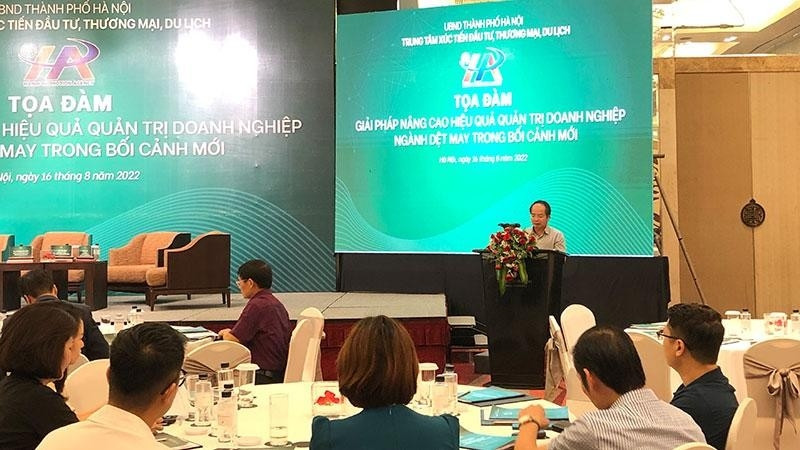Speaking at the opening of the seminar, Le Tu Luc, Deputy Director of the Hanoi Promotion Agency, said that Vietnam's textile and garment industry has always been one of Vietnam's main export industries for many years.
2022 is the time when textile enterprises gradually recover from the heavy impact of the COVID-19 pandemic. In the first six months of 2022, textile and garment export turnover was estimated at 22.3 billion USD, up 17.7% over the same period in 2021. The trade surplus was 8.86 billion USD, up 32% compared to the first six months of 2021. This can be seen as a great effort of the textile and garment enterprises in the context of the world's economic difficulties, emphasised by Le Tu Luc.
After the impact of the COVID-19 epidemic, textile and garment enterprises are focusing on investing in research and development of raw materials and auxiliary materials for production, improving their initiative to reduce dependence on imported raw materials, and at the same time, seek to quickly adapt to new business conditions, such as diversifying product lines and markets, and the application of a new payment mechanism that is different from the traditional way of buying and selling before.
For the textile and garment industry to overcome challenges and make good use of the “golden” opportunities in development, the participants in the seminar proposed solutions to attract investment in the textile and garment industry, especially in the textile-dyeing projects, and production of new materials of natural origin, which are environmentally friendly.
At the same time, it is necessary to improve management capacity and develop human resources for textile and garment enterprises. Enterprises should continue to promote the development of brands and new products, diversify the supply of raw materials and accessories and export markets, and "green" the textile industry.
The goal of export turnover by 2030 is to reach 68 billion USD to 70 billion USD.
The Hanoi Promotion Agency (HPA) is a public non-business unit directly under the Hanoi Municipal People’s Committee, which has the function of proposing and organising programmes and plans on promoting investment, trade, tourism, agriculture and external services of Hanoi. HPA also collects recommendations and coordinates with relevant agencies to propose the Municipal People’s Committee to issue policies to attract investment, trade, tourism and agricultural production. In addition, the agency provides support, consulting and services for domestic and foreign enterprises, organisations and individuals, to find investment and business opportunities in Hanoi and other provinces and cities, in Vietnam and abroad.
The HPA and the Departments of Industry and Trade, and Agriculture and Rural Development have implemented many trade promotion programmes, to connect trade between Hanoi and other provinces and cities nationwide, following Programme No. 313/CTr-UBND, approved by the Hanoi People’s Committee on December 28, 2021 on Hanoi Investment, Trade and Tourism Promotion Programme in 2022 and Plan No. 261/KH-UBND dated November 19, 2021 on organising regional linkage activities and supporting the connection of goods supply and demand between Hanoi and other provinces and cities, in the field of industry and trade for 2022.
According to Nguyen Anh Tuan, the Deputy Director of the Foreign Investment Department, under the Ministry of Planning and Investment, the textile and garment industry is lacking linkages in the value chain. Vietnam has a trade surplus for yarn and garments, but a large deficit for fabrics. The yarn produced is not used domestically for weaving, but mainly for export. Fabrics produced domestically can only meet around 50% of the demand, causing Vietnam to import more than 10 billion USD of all kinds of fabrics each year.
Meanwhile, new-generation free trade agreements (FTAs) have imposed requirements on rules of origin, yarns and fabrics must be produced in Vietnam and used in Vietnam or FTA countries, so they can be certified rules of origin and enjoy preferential tax. Therefore, textile enterprises are forced to focus on developing along the entire chain, forming a domestic value chain.
In addition, at present, Vietnam's textile and garment industry is facing fierce competition from countries with large textile and garment export revenue, such as China, Bangladesh, Turkey, India, etc. In the domestic market, there is also fierce competition with major foreign brands already present in Vietnam.
Vice President and General Secretary of the Vietnam Textile and Apparel Association, Truong Van Cam said that the importing markets of Vietnam's textiles and garments are mostly high-class and fastidious markets, with high requirements for quality, product hygiene and safety, environment, recycling content and labour standards. World trends are also changing, moving from fast fashion to sustainable fashion (increasing product life, recycling rate, carbon fees, etc.).
For the textile and garment industry to overcome challenges and make good use of the "golden" opportunities in development, the participants of the seminar suggested that there should be solutions to attract investment in the textile and garment industry, especially in the projects of textile-dyeing, production of new materials of natural origin and being environmentally friendly. At the same time, it is necessary to improve management capacity and develop human resources for textile and garment enterprises. Enterprises also need to continue to promote the development of brands and new products, diversify the supply of raw materials and auxiliary materials and export markets, and "greening" the textile and garment industry, etc. The goal of export revenue by 2030 is expected to reach 68-70 billion USD.
















